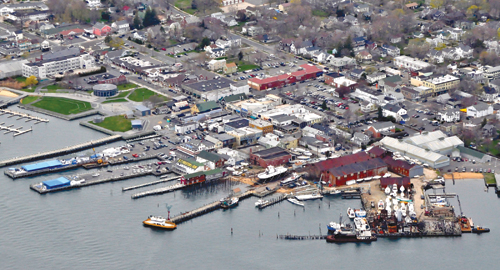Changes to Greenport waterfront program have some miffed
Greenport Village’s Local Waterfront Revitalization Program is slowly morphing into the municipality’s comprehensive plan, a move that has angered some residents.
During a roundtable discussion July 25 at the Third Street firehouse, about 20 people — including village administrator David Abatelli and Village Board members David Murray and Chris Kempner — heard planning consultants speak on how the proposed changes aim to improve the area’s quality of life.
While many towns and villages limit their LWRPs to how their waterfronts can be used, Greenport’s plan, first completed in 1988 in an effort to deter waterfront condominium development, may now cover the entire village.
The LWRP was last updated in 1998 and a Harbor Management Plan was added for the construction of Mitchell Park.
David Smith of VHB Engineering, Surveying & Landscape Architecture, based in Watertown, Mass., said the updated report has been nearly two years in the making.
Enhancing drainage throughout the village is one of the newest proposals in the draft.
Water running off impervious surfaces, such as rooftops, roads and parking lots, picks up pollutants on its way to nearby waterways. Through stormwater mitigation, pollutants are typically redirected and filtered through permeable surfaces.
The village is currently finalizing its strategy to comply with new federal and state mandates aimed at improving water quality in the bays and the Sound.
Under orders from both the U.S. Environmental Protection Agency and state Department of Conservation, the village must act not only to improve the quality of water that fails to meet federal clean-water standards, but also must record and report each plan developed and each step taken.
Southold Town faces the same requirement.
The state Department of Environmental Conservation has designated Greenport Village as a municipal “separate storm sewer system” operator, commonly known as MS4.
The MS4 designation means the village must develop, implement and enforce a stormwater management program requiring developers to submit more stringent pollution prevention plans to ensure building projects don’t contaminate wetlands. Mr. Smith said the village’s MS4 plan will be integrated into its LWRP.
Many who attended last week’s meeting expressed their displeasure with Mr. Smith’s presentation after he failed to provide concrete details about proposed zoning changes. When residents asked for the locations of properties slated for rezoning, Mr. Smith pointed to a few areas on a map projected on a screen and said he couldn’t provide exact locations because he didn’t know which streets those properties were on.
“We have nothing to review, so how can we comment?” village resident Robert Hamilton asked.
Although the over-200-page report was posted on the village website earlier this month, residents described downloading the large document and reading through it as “laborious.” The bulk of it contains decades-old information about the original plan and the most updated information is located at the back of the document.
Michael Osinski, former Village Trustee and owner of Widow’s Hole Oyster Company, said the village should focus on presenting details about the proposed zoning changes so that resident don’t have to “pull teeth” to find information.
“Why hasn’t anyone stood up there and given us a listing of what the pending changes are?” Mr. Osinski asked. “Isn’t that the purpose of this meeting?”
Village residents Bill Swiskey and John Saladino said the last 10 to 15 pages of the report should have been created as a separate digital document so that residents could find the proposed updates. In addition, they suggested the village hold another, more formal, meeting. The village advertised the July 25 meeting as a “community conversation” and it wasn’t recorded.
Mr. Abatelli said the roundtable discussion format was decided on so that residents could express their comments freely. He said he will schedule another public meeting and will arrange for it to be recorded.
Following a 30-day written comment period, environmental studies must be completed before the Village Board can take any action on the proposed plan.
“A lot has to happen before there’s a zone change,” Mr. Abatelli said. “It’s long. It’s slow. It’s painful. And after the dust settles, not much is changed.”
In addition to proposing zoning changes, the $67,000 draft report recommends building a support facility for aquaculture, expanding McCann Campground on Moore’s Lane, enhancing Moore’s Woods and creating a trail from Long Island Sound to Peconic Bay.
Mr. Swiskey questioned why the draft proposes new development instead of focusing on enhancing the waterfront.
“What’s Moore’s Woods got to do with the waterfront?” Mr. Swiskey asked. “This sounds like somebody’s dream and everyone else’s nightmare.”
Hard copies of the report are located at Village Hall and Floyd Memorial Library. Residents can email their comments to Mr. Abatelli at [email protected].









